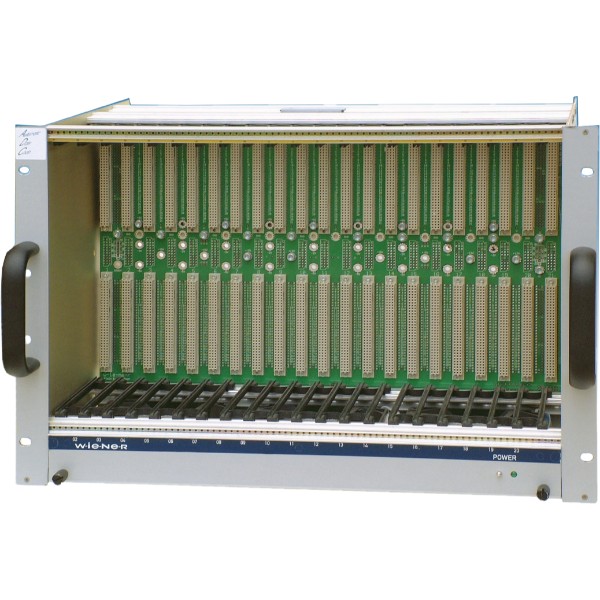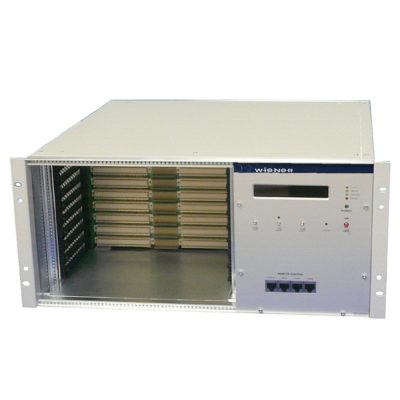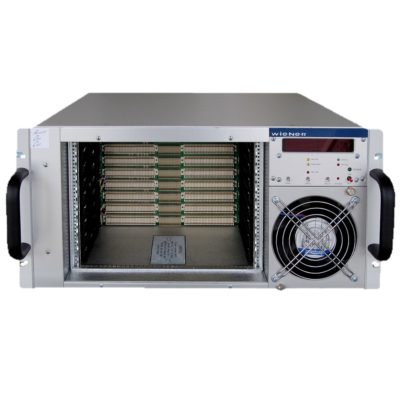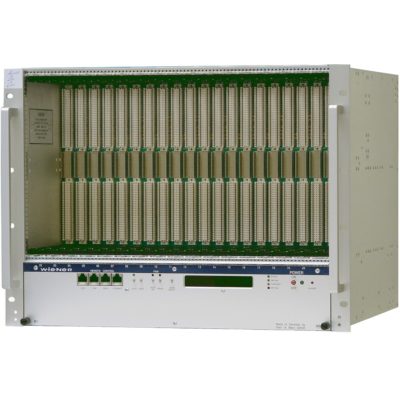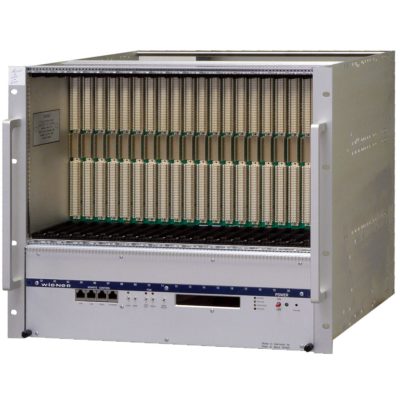6U VME64x NIX-I
The low-cost / industry standard VME64x NIX-I series, provides basic, full size VME crates with low noise 6000 series based power supply technology and a removable fan tray.
Optionally remote control via CAN-bus is available.
Features
- 7U VME-Bin VM4 with 21 Slots for 6U x 160mm VME64x modules,
- IEEE 1101.10 compliant mechanics with enhanced EMC / ESD
- 21 slot J1/J2 VME64x monolithic backplane (J0 optional)
- Plug-in, replaceable VME fan tray UL 4 with high efficient 3- fold DC fan tray blowers, one unit height, air inlet from bottom, optionally watched by temperature sensors and / or variable fan speed
- VME-Power-Supply UEP4, low noise VHF switching technology based, up to 650W output power, rear side mounted (behind J1 area!, no 6U transition possible)
- Optionally with CAN-bus interface (CAN-bus remote monitoring and controlling).
- CE-conformity
- Dimensions: 19″ (482mm) x 7U (311mm) x 325mm [whd], weight: ca. 11.7 Kg
Ordering Information
Standard configurations (others possible by request).
| Crate Version | Backplane | +5V | +3.3V | +12V | -12v |
|---|
DISCONTINUED!
Technical Information
VME64x Backplanes
All WIENER VME 64x multi-layer backplanes are outfitted with 5-row 160 pin connectors for J1 and J2 as well as optionally with 133 pin hard metric connector for J0. The busses have active on board termination and active automatic daisy-chain (CBLT compatible!). Available with up to 21 slots.
W-Ie-Ne-R’s special current multilayer made of “z”-bended copper sheets, further stiffens the 4.8mm thick board.
- Strip line technology suitable for data rates of 320Mbyte/s (64bit)
- High power distribution by current multiplayer / bus bar system
- Excellent RF shielding
- Optimized filtering (electrolytic and ceramic filter-capacitors)
- Minimized ground shift and cross talk
- Automatic daisy chain
- flat cable connector for sense and control
- Provision for up to 8 temperature sensors (module temp. checking)
- Sense circuit protection by PTC- resistors (Optionally)
- Special version for VIPA (VME in Physics) and CERN VME430 style
| Power per slot | VME 64x | VME 64x-V430 | VME64xP |
|---|---|---|---|
| (20°C / 70°C) | J1-J0-J2 | J1-Jaux-J2 | J1-J0-J2 Slot 2- 21 |
| 3,3V | 17A / 12A | 17A / 12A | 17A / 12A |
| 5V | 15,3A / 10,8A | 15,3A / 10,8A | 27A / 19A |
| +/-12V | 1,7A / 1,2A | 1,7A / 1,2A | 1,7A / 1,2A |
| +/-15V | 3,2A / 2,5A | ||
| -5,2V | 19A / 15A | ||
| -2V | 9,5A / 7,5A | ||
| Vw, Vx, Vy, Vz | 4A / 3A | ||
| V1, V2 | 1,7A / 1,2A | 1,7A / 1,2A | 1,7A / 1,2A |
| Layers | 10 | 10 | 18 |
VME / VME64x NIXI
| Module cage formats | 6Ux160mm, VME standard |
|---|
Power Supply | |||
|---|---|---|---|
| Rated mains input range | 106- 230VAC ± 15% (90...265VAC) | ||
| Rated input current | Sinusoidal 16A for suffix H input, 32A for suffix K input | ||
| Inrush current: | limited to rated input current (cold unit) | ||
| Input fuse: | external, intern on special request | ||
| Isolation Inp.-outp.: | CE EN 60950, ISO 380, VDE 0805, UL 1950, C22.2.950 | ||
| DC output power: | H for 1000... <3000W (92 …265VAC) | ||
| K for 2000... <6000W (92 …265VAC) | |||
H input outfitted with removable power cord (3*1,5mm2) for 16A nominal input current, | |||
K input (6U power box) is equipped with 2m fixed power cord for up to 32A nominal. | |||
| Regulation | |||
|---|---|---|---|
| static: | MEH 550W/650W | <15mV | (+/-100% load, +/- full mains range) |
| MDH (20A) | <0,05% | (+/-100% load, +/- full mains range) | |
| MDL / MDH | <0,1% | (+/-100% load, +/- full mains range) | |
| dynamic : | MEH, MDH | <100mV | (+/-25% load) |
| MDL / MDH | <0,7% | (+/-25% load) | |
| Recovery time : | +/-25% load | within +-1% | within +-0.1% |
| Modules 550W | 0.2ms | 0,5ms, | |
| Modules 650W | 0,5ms | 1,0ms | |
| MDL / MDH | 0.0ms | 1.0ms | |
| (Conditions: Current slope <1000A/ms, 21mF per 100A ^ 1mF per slot) | |||
| Sense compensation range: | difference between min. and max. output voltage | ||
Available modules
| Type | Channels | Voltage range | Peak output / power | Noise and ripple |
| MEH | 1 | 2... 7,0V | 115A / 550W | 10mVpp, (0-20MHz ), <2mVrms (0-30MHz |
| MDH | 2 | 7...16V | (+/-) 20A / 250W (500W) | <15mVpp, (0-20MHz ), <2mVrms (0-30MHz) |
EMC Compatibility | ||
|---|---|---|
| EMA. | EN 61 000-6-3:2001 | [RF emission] |
| EN 55 022:1998 + Corr:2001 + A1:2000 Class B | conducted noise | |
| EN 55 022:1998+ Corr:2001 + A1:2000 Class B | radiated noise | |
| EN 61 000-3-2:2001 | harmonics | |
| EN 61 000-3-3:1995 +Corr:1997 +A1:2001 | flicker | |
| EMB | EN 61 000-6-2:2001 | [immunity] |
| EN 61 000-4-6:1996 + A1:2001 | injected HF currents | |
| EN 61 000-4-3:1996 + A1:1998 + A2:2001 | radiated HF fields incl. ”900MHz” | |
| EN 61 000-4-4:1995 + A1:2001 | Burst | |
| EN 61 000-4-5:1995 + A1:2001 | Surge | |
| EN 61 000-4-11:1994 + A1:2000 | voltage variations | |
| EN 61 000-4-2:1995 + A1:1998 + A2:2001 | ESD | |
| Operation temperature: | 0… 50°C ambient without derating, Storage:-30°C ... +85°C | |
| Temperature coefficient: | < 0,2% / 10K | |
| Stability: | 10mV or 0,1% / 24 hours, 25mV or 0,3% / 6 month | |
| Current limits: | adjustable to any lower level | |
| Voltage rise characteristics: | monotonic 50ms, processor controlled. | |
| Overvoltage protection: | crow bar protection trip off adjusted to 125% of nominal voltage each output | |
| DC Off (trip off): | within 5ms if >5% deviation from adjusted nominal values, after overload, overheat, overvoltage, undervoltage (bad status), and fan fail, if temperatures exceed 125°C at heat sinks. Limits programmable. Outputs discharged by crow bars, when power supply tripped- or switched Off. | |
| Efficiency: | 75% ... 85%, depends on used modules | |
| M F O T (Maintenance Free peration Time): | ||
| internal blowers: | 40°C ambient | >65 000 h |
| 25°C ambient | 100 000 h | |
| electronics: | 40°C ambient | >100 000 h |

